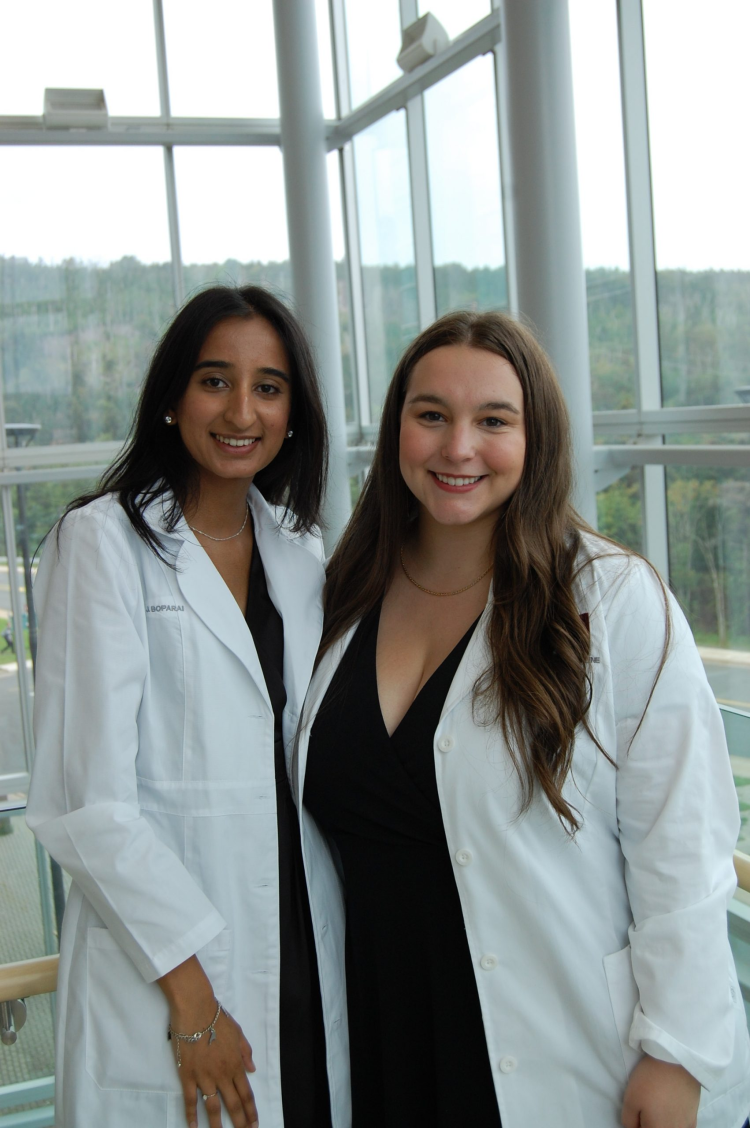Two Memorial University medical students are on a mission to equip future physicians with a deeper understanding of how identity and culture shape patient care.
Third-year Faculty of Medicine students Josheil Boparai and Jessica Canning co-founded and launched Beyond the Surface, a monthly newsletter that takes a deeper look into how medical conditions and health experiences present differently across populations.

From left are MD students Josheil Boparai and Jessica Canning. Photo: Submitted
The initiative simultaneously enhances their medical education and encourages culturally competent care, the learners say.
You can read the Beyond the Surface newsletter here.
Promoting awareness, challenging assumptions
Ms. Canning, originally from Grand Falls-Windsor, N.L., studied biochemistry at Memorial before starting medical school.
She currently serves as vice-president of equity, diversity and inclusion (EDI) for the Medical Students' Society.
"As medical students, we're taught a lot about disease initially from a narrow lens," she explained. "Through Beyond the Surface, I hope to promote awareness, challenge assumptions and help equip future physicians to provide more inclusive care in a diverse country like Canada."
Dr. Taryn Hearn is the Faculty of Medicine's associate dean of undergraduate medical education.
"Our family doctor spoke Punjabi and tailored her care to our background." Josheil Boparai
She says early medical education is focused on introducing learners to performing clinical skills and understanding disease states.
"This newsletter is a wonderful resource that supports their journey as life-long learners by preparing them for the diversity of patients and presentations they will see in their training and careers," she said.
Culturally sensitive medicine
Ms. Boparai's passion for health equity is rooted in her own upbringing.
The daughter of Punjabi immigrants, she saw first-hand the impact of culturally sensitive medicine.
"Our family doctor spoke Punjabi and tailored her care to our background," she recalled. "She gave us advice we could realistically apply within our lifestyle and traditional foods. That showed me what medicine can look like when it's truly inclusive and it planted the seed for what would eventually become Beyond the Surface."
Ms. Boparai came to Memorial for medical school from the Brampton-Mississauga area in Ontario.
"There's a lot of diversity there. You see a lot of people of your own colour, and coming to Newfoundland and Labrador is a bit of a culture shock. There's a lot less diversity."
She says being in a class made up primarily of white students also made her more conscious of her own appearance.
"It made me realize the responsibility that's on our shoulders, as a minority, to represent people who aren't here."
EDI lens
Ms. Boparai's experience inspired her to consider how ethnicity and other demographic factors shape the way patients present and how they are perceived in clinical settings.
She says physicians see patients with many demographic factors that intersect.
"You may see someone who is of low socio-economic status, low education and also an ethnic minority."
When creating the newsletter, the pair envisioned a resource that examined medical conditions from an EDI lens, and that students could engage with outside of class.
"Is [rosacea] truly less common in non-white populations, or is it just being underdiagnosed?" Jessica Canning
They landed on a web-based newsletter that was informative, digestible and accessible.
The first issue, published in June, focused on rosacea, a skin condition.
"Classically, we think of rosacea as redness and flushing on the skin, which is very obvious on a white person," explained Ms. Canning. "But it's not so obvious if the person has a darker skin colour. It might look violet, purple, brown or blue. What is their presentation like? How does management differ, and is it truly less common in non-white populations, or is it just being underdiagnosed?"
Many hats
To ensure clinical accuracy, each newsletter is reviewed by a faculty expert.
Dr. Bolu Ogunyemi, a dermatologist and faculty member at Memorial, reviewed the first issue.
The students say having an expert who works in the field review the newsletters before they are posted helps establish credibility.
"Although it was created by medical students for medical students, there's no reason why practising physicians couldn't also read it," Ms. Canning said.
"He gave us quite a bit of good feedback, especially since, as medical students, we don't really know the treatments yet, or how they clinically apply," Ms. Boparai added.
The second issue, released in early July, examined menopause across ethnicities, an important topic in an aging population.
The Menopause Foundation of Canada even highlighted the piece on social media. Subsequent issues covered physical activity guidelines, pain treatment, ADHD and endometriosis.
More to come
The team has now grown to 13 students from medical schools across Canada, which will help ensure the project is sustainable.
As for upcoming topics, the students have identified a long list: everything from atypical depressive symptoms to how heart disease presents differently in women.
"As physicians, we are going to be wearing many hats," said Ms. Boparai. "Our clinical placement came at a good time, when the newsletter was just getting started, because it made us realize how important these topics really are.
"I saw my preceptor not only play the role of a physician, where they are prescribing and diagnosing, but also advocating for patients and teaching them things they perhaps didn't know about," she continued. "We have to address the gaps in our own knowledge so we can become better physicians."
Follow the students' medical conversations and updates on Instagram.













